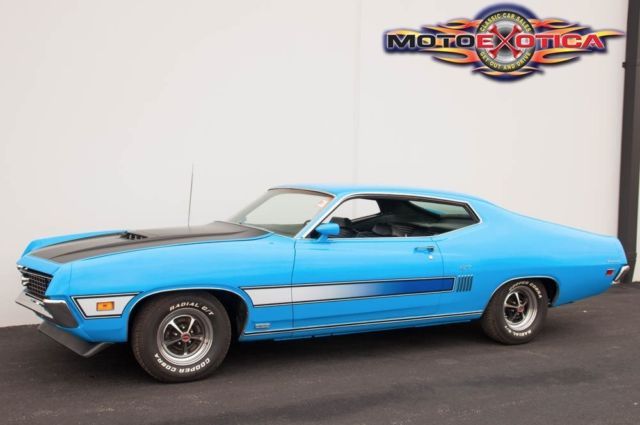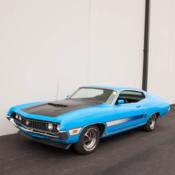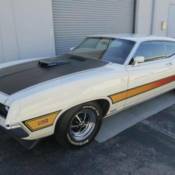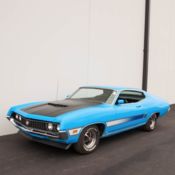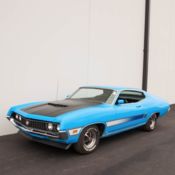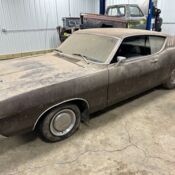1970 Ford Torino GT Fastback 429 Cobra Jet
1970 Ford Torino Cobra
1970 Ford Torino GT Fastback Description1970 Ford Torino GT Fastback 429 Cobra Jet
Torino GT with factory C-code 429 CID Cobra Jet engine with Rochester Quadrajet 700 cfm carburetor Motor Trend's Car of the Year for 1970 One of 255 produced with this engine/transmission pair Same owner for 22 years! Finished in vivid Grabber Blue exterior with black vinyl (code 6A) interior C6 three-speed automatic transmission (code U) Ford nine-inch rear end with 3.25 gearing (code 9) Rare SelectAire factory air conditioning Power steering Dual exhausts with chrome tips Black body stripes Dual sport mirrors and hood scoop Magnum 500 wheels with Cooper Cobra radials Documentation includes Deluxe Marti Report, original owner's manual and hard to find factory build sheetLooking to relive the big sport coupe American muscle car era all over again? Want to have the power and sound of Ford's 429cid Cobra Jet big block engine? MotoeXotica Classic Cars has a ride ready to take back to 1970 with this Grabber Blue 1970 Ford Torino GT Fastback. This car received loving care from the same previous owner for 22 years!
Dressed in Grabber Blue paint that is in excellent condition, the order for this car was received on June 24, 1970, built on July 20, 1970 (13 days behind schedule) in Ford's Atlanta, Georgia factory and shipped to the Kansas City area, where it was sold on July 30, 1970 at James Campbell, Inc., on 40 Highway in Blue Springs, Missouri. It was equipped with the following features - black laser stripes, G70x14 belted white sidewall tires, power steering, rarely ordered SelectAire air conditioning, AM radio and tinted glass.
The car's glass panels are in very good order. The only blemish is a score arc from a previous driver's windshield wiper. The car's lights are in excellent order, as are the tires, Cooper Cobra GT radials, 225/70R14 at all four corners and Magnum 500 wheels. The car's body panels are solid and straight, the engine bay is very tidy, the battery looks new and the bumpers are also in fantastic shape.
Under the scooped hood is Ford's 429 CID Cobra Jet big-block V-8 (code C) with a Rochester Quadrajet 700 cfm carburetor, larger camshaft, 11.3:1 compression ratio and a special set of cylinder heads. It breathes via dual exhausts with chrome tips and mated to a C6 three-speed automatic transmission (code U) and a Ford nine-inch rear end with 3.25 gearing (code 9). The Ford 385 engine family (the name came from the 3.85 inch crankshaft stroke of the 460 V-8 was the Ford Motor Company's final big block V8 engine design, replacing the Ford MEL engine and gradually superseding the Ford FE engine family.) This design was a departure from the paradigm, utilizing thin wall casting methods and a skirtless block to reduce weight.
Inside, the black vinyl bench seat is in excellent condition, with matching carpet in very good order. The black headliner is in good shape and the instrument panel is in mostly good condition but the gauge faces present some fade. The factory two-spoke steering wheel is in very good shape, as are the door panels. The dual sport sideview mirrors (there is no rearview mirror) and the gear shifter are in good condition. Completed the interior is a factory Philco AM radio. Interiors on the Torino were all new for 1970. The dashboard featured a linear style speedometer centered on the driver, and a new "ribbon" style tachometer was an option for V8 models. A temperature gauge was the only available gauge; oil pressure and electrics were monitored with warning lights only. High back bucket seats were available for all two-door models, as was an optional console; the GT model no longer had the former as standard features. All two-door hardtop, SportsRoof and convertible models featured "DirectAire" ventilation systems as a standard feature, which eliminated the need for side vent windows. This Torino is factory equipped with air conditioning but currently is inoperable but is complete. Also the horn is inoperable.
For 1970, the Torino now became the primary model and the Fairlane was a sub-series of Torino. Ford moved away from emulating the boxy lines of the full-size Fords to a completely new body for the 1970 Torino/Fairlane line, influenced by coke bottle styling. Just as tailfins were influenced by jet aircraft of the 1950s, stylists such as Ford stylist Bill Shenk who designed the 1970 Ford Torino were inspired by supersonic aircraft with narrow waists and bulging forward and rear fuselages needed to reach supersonic speeds.
The new car featured a more prominent long hood, short deck styling and was longer, lower and wider than the 1969 models. The roofline was lower, while all models now featured a much less formal roofline than previous years. The windshield rake was increased and the SportsRoof models had an even flatter fastback roofline. The overall styling appeared much more aerodynamic than years previous and featured a pointed front end. The grille covered the full width of the front fascia and surrounded the quad headlights. The front fender line extended to front door, sloping downward and gradually disappearing in the quarter panel. Both front and rear bumpers were slim tight fitting chromed units that carefully followed the bodylines. The taillights were situated in the rear panel above the bumper and were now long rectangular units with rounded outer edges.
The new body for 1970 added inches and pounds to the Torino. All cars grew by about five inches in length and now rode on a 117-inch wheelbase. The wheel track was widened [front 60.5″, rear 60″], to help the Torino improve its road holding abilities. Although the track was widened, the suspension remained unchanged from the 1969 models. Weight was up for most models by at least 100 lbs.
The Torino GT came standard with non-functional hood scoop molded into the hood, GT emblems (including the center of the grille), dual color-keyed sport mirrors, full width tail lights with a honeycomb effect (the center portion was non-functional but reflective), black decklid appliques (SportsRoof only), and hub caps with wheel trim rings. Standard tires for the GT were E70-14 fiberglass belted tires, while convertibles wore F70-14s. New options for the Torino GT were a reflective laser stripe, which ran down the middle of the side of the Torino from the front fender to the door, and hideaway headlamps. Motor Trend magazine tested a 1970 Torino GT SportsRoof with a 429 CJ, C-6 Automatic and 3.50:1 gears, and obtained a 0-60 mph time of 6.0 seconds, while the quarter mile took 14.4 seconds at 100.2 mph.
Overall, 1970 was a successful year for Torino. It was a well-received car by the automotive press and was selected as the Motor Trend Car of the Year for 1970. Motor Trend said the Torino was "Not really a car line in the old sense, but a system of specialty cars, each for a different use ... from luxury to performance." Ford produced 230,411 Torinos for 1970, along with 110,029 Fairlanes and 67,053 Falcons, for a total production of 407,493 units.
Documentation includes Deluxe Marti Report, original owner's manual and hard to find factory build sheet.
Competition to this Ford in 1970 included AMC's Javelin two-door hardtop, Chevrolet's Chevelle SS 454, Dodge's Coronet Super Bee two-door hardtop, Mercury's Montego MX two-door hardtop and Studebaker's Avanti II.
This car is currently located at our facility in St. Louis, Missouri. Current mileage on the odometer shows 29,650 miles. It is sold as is, where is, on a clean and clear, mileage exempt title. GET OUT AND DRIVE!!!
CLICK HERE TO VIEW OUR YOUTUBE VIDEO
VIN: 0A35C270805
Note: Please see full terms and conditions listed below that pertain to the purchase of any said vehicle, thank you.
- Make: Ford
- Model: Torino
- SubModel: Torino GT Fastback
- Type: Coupe
- Trim: Cobra
- Year: 1970
- Mileage: 29,650
- VIN: 0A35C270805
- Color: Blue
- Engine size: V8
- Number of cylinders: 8
- Transmission: Automatic
- Drive type: RWD
- Interior color: Black
- Vehicle Title: Clear Want to buy? Contact seller!
